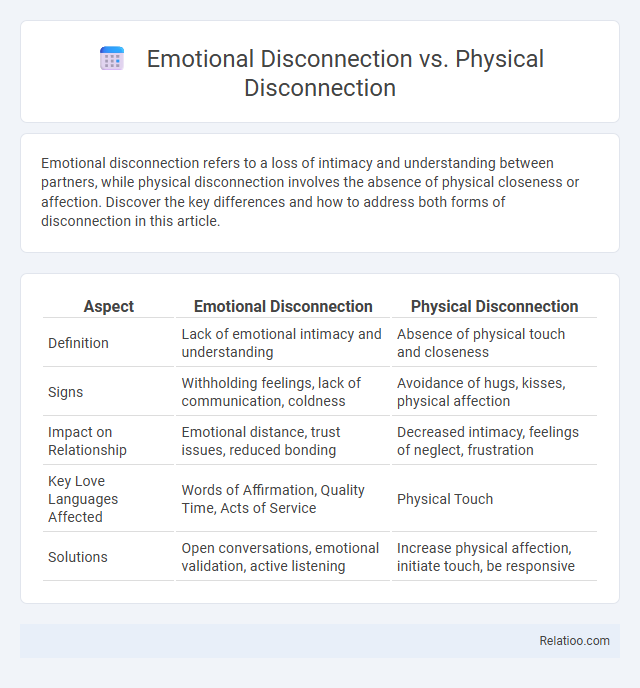Emotional disconnection refers to a loss of intimacy and understanding between partners, while physical disconnection involves the absence of physical closeness or affection. Discover the key differences and how to address both forms of disconnection in this article.
Table of Comparison
| Aspect | Emotional Disconnection | Physical Disconnection |
|---|---|---|
| Definition | Lack of emotional intimacy and understanding | Absence of physical touch and closeness |
| Signs | Withholding feelings, lack of communication, coldness | Avoidance of hugs, kisses, physical affection |
| Impact on Relationship | Emotional distance, trust issues, reduced bonding | Decreased intimacy, feelings of neglect, frustration |
| Key Love Languages Affected | Words of Affirmation, Quality Time, Acts of Service | Physical Touch |
| Solutions | Open conversations, emotional validation, active listening | Increase physical affection, initiate touch, be responsive |
Understanding Emotional Disconnection
Emotional disconnection involves a lack of emotional responsiveness or intimacy, often leading to feelings of isolation and misunderstanding in relationships. Unlike physical disconnection, which refers to the absence of physical presence or touch, emotional disconnection impacts your ability to connect on a deeper, psychological level. Understanding emotional disconnection is crucial for recognizing relationship challenges and fostering meaningful communication and empathy.
Defining Physical Disconnection
Physical disconnection refers to the tangible separation or distance between individuals, such as living apart, limited physical contact, or geographic isolation. Emotional disconnection involves a lack of emotional intimacy, empathy, or understanding, which can occur even when people are physically together. Understanding your physical disconnection helps address barriers that impact relationship dynamics and overall well-being.
Key Differences Between Emotional and Physical Disconnection
Emotional disconnection involves a lack of empathy, intimacy, and understanding between individuals, affecting the depth of relationships, while physical disconnection refers to the absence of physical presence or touch, impacting closeness but not necessarily emotional bonds. You may experience emotional disconnection even when physically close, whereas physical disconnection can be bridged through communication and emotional support. Understanding these key differences helps in addressing relationship challenges by distinguishing between emotional needs and physical proximity.
Causes of Emotional Disconnection in Relationships
Emotional disconnection in relationships often stems from unresolved conflicts, lack of communication, and emotional neglect, which can create feelings of isolation despite physical proximity. Physical disconnection refers to the absence of physical intimacy or presence, but it does not always imply emotional distance, whereas general disconnection encompasses detachment on multiple levels including emotional, physical, and psychological. Your awareness of these distinct causes is crucial to addressing and healing emotional disconnection effectively.
Causes of Physical Disconnection in Relationships
Physical disconnection in relationships often stems from factors such as prolonged stress, unresolved conflicts, or lifestyle changes that reduce shared time and intimacy. Health issues like chronic illness or fatigue can also contribute significantly to decreased physical closeness. These causes contrast with emotional disconnection, which centers on feelings of mistrust or lack of communication, highlighting the distinct nature of physical separation within relational dynamics.
Signs and Symptoms of Emotional Disconnection
Emotional disconnection manifests through signs such as persistent feelings of loneliness, lack of empathy, and difficulty expressing or recognizing emotions, often occurring despite physical proximity. Symptoms include detachment from loved ones, reduced emotional responsiveness, and a sense of numbness or apathy towards relationships. Unlike physical disconnection, which involves a tangible separation, emotional disconnection reflects an internal barrier impairing genuine emotional engagement and intimacy.
Signs and Symptoms of Physical Disconnection
Physical disconnection manifests through symptoms such as chronic fatigue, frequent illnesses, persistent muscle tension, and unexplained pain, indicating a disrupted connection between body and mind. Signs include decreased physical responsiveness, reduced sensory awareness, and impaired motor functions, often accompanied by a feeling of numbness or detachment from bodily sensations. Unlike emotional disconnection, which affects mental and emotional engagement, physical disconnection specifically impacts somatic awareness and physiological health.
Impact of Emotional Disconnection on Relationships
Emotional disconnection in relationships often leads to feelings of isolation, reduced intimacy, and a breakdown in communication, which can severely harm trust and bonding. Unlike physical disconnection, which might involve mere absence or distance, emotional disconnection impacts the core of your relational dynamics, causing a lack of empathy and understanding between partners. Addressing emotional disconnection is crucial to preserving relationship health and fostering genuine connection.
Effects of Physical Disconnection on Relationship Dynamics
Physical disconnection in relationships often leads to reduced intimacy, increased misunderstandings, and emotional distance, impacting trust and communication between partners. You may experience feelings of loneliness and detachment, which can exacerbate conflicts and weaken relational bonds over time. Maintaining consistent physical presence and touch is crucial for reinforcing emotional security and connection within a healthy relationship dynamic.
Strategies to Reconnect Emotionally and Physically
Emotional disconnection often stems from unresolved conflicts or lack of communication, while physical disconnection typically involves reduced intimacy or absence of shared activities; understanding these distinctions is crucial for effective reconnection. Strategies to reconnect emotionally include active listening, expressing vulnerability, and engaging in meaningful conversations that validate each other's feelings. For physical reconnection, prioritize shared experiences such as physical touch, date nights, or activities that foster closeness, helping your relationship regain warmth and intimacy.

Infographic: Emotional Disconnection vs Physical Disconnection
 relatioo.com
relatioo.com